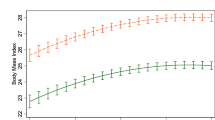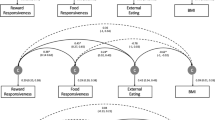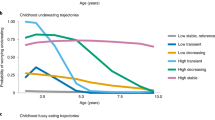Abstract
Background/Objectives
Obesity polygenic risk scores (PRS) explain substantial variation in body mass index (BMI), yet associations between PRSs and appetitive traits in children remain unclear. To better understand pathways leading to pediatric obesity, this study aimed to assess the association of obesity PRSs and appetitive traits.
Subjects/Methods
This study included 248 unrelated children aged 9–12 years. DNA from the children was genotyped (236 met quality control thresholds) and four weighted polygenic risk scores from previous studies were computed and standardized: a 97 SNP PRS, 266 SNP pediatric-specific PRS, 466 SNP adult-specific PRS, and ~2 million SNP PRS. Appetitive traits were assessed using a parent-completed Child Eating Behavior Questionnaire, which evaluated food approach/avoidance traits and a composite obesogenic appetite score. BMI was directly measured and standardized by age and sex. Three associations were evaluated with linear regression: (1) appetitive traits and BMI, (2) PRSs and BMI, and (3) PRSs and appetitive traits, the primary association of interest.
Results
Expected positive associations were observed between obesogenic appetitive traits and BMI and all four PRSs and BMI. Examining the association between PRSs and appetitive traits, all PRSs except for the 466 SNP adult PRS were significantly associated with the obesogenic appetite score. Each standard deviation increase in the 266 SNP pediatric PRS was associated with an adjusted 2.1% increase in obesogenic appetite score (95% CI: 0.6%, 3.7%, p = 0.006). Significant partial mediation of the PRS-BMI association by obesogenic appetite score was found for these PRSs; for example, 21.3% of the association between the 266 SNP pediatric PRS and BMI was explained by the obesogenic appetite score.
Conclusions
Genetic obesity risk significantly predicted appetitive traits, which partially mediated the association between genetic obesity risk and BMI in children. These findings build a clearer picture of pathways leading to pediatric obesity.
This is a preview of subscription content, access via your institution
Access options
Subscribe to this journal
Receive 12 print issues and online access
$259.00 per year
only $21.58 per issue
Buy this article
- Purchase on Springer Link
- Instant access to full article PDF
Prices may be subject to local taxes which are calculated during checkout
Similar content being viewed by others
Data availability
The datasets generated during and/or analyzed during the current study are available from the corresponding author on reasonable request.
References
Sahoo K, Sahoo B, Choudhury AK, Sofi NY, Kumar R, Bhadoria AS. Childhood obesity: causes and consequences. J Family Med Prim Care. 2015;4:187–92.
Fryar CD, Carroll MD, Ogden CL. Prevalence of overweight, obesity, and severe obesity among children and adolescents aged 2–19 years: United States, 1963–1965 through 2015–2016. National Center for Health Statistics; 2018.
Albuquerque D, Nobrega C, Manco L, Padez C. The contribution of genetics and environment to obesity. Br Med Bull. 2017;123:159–73.
Locke AE, Kahali B, Berndt SI, Justice AE, Pers TH, Day FR, et al. Genetic studies of body mass index yield new insights for obesity biology. Nature. 2015;518:197–206.
Loos RJF, Yeo GSH. The genetics of obesity: from discovery to biology. Nat Rev Genet. 2022;23:120–33.
Carnell S, Wardle J. Appetite and adiposity in children: evidence for a behavioral susceptibility theory of obesity. Am J Clin Nutr. 2008;88:22–9.
Llewellyn CH, Fildes A. Behavioural susceptibility theory: Professor Jane Wardle and the role of appetite in genetic risk of obesity. Curr Obes Rep. 2017;6:38–45.
Wardle J, Guthrie CA, Sanderson S, Rapoport L. Development of the children’s eating behaviour questionnaire. J Child Psychol Psychiatry. 2001;42:963–70.
Llewellyn CH, van Jaarsveld CH, Johnson L, Carnell S, Wardle J. Nature and nurture in infant appetite: analysis of the Gemini twin birth cohort. Am J Clin Nutr. 2010;91:1172–9.
van Jaarsveld CH, Boniface D, Llewellyn CH, Wardle J. Appetite and growth: a longitudinal sibling analysis. JAMA Pediatr. 2014;168:345–50.
Richardson TG, Sanderson E, Elsworth B, Tilling K, Davey Smith G. Use of genetic variation to separate the effects of early and later life adiposity on disease risk: Mendelian randomisation study. BMJ. 2020;369:m1203.
Yengo L, Sidorenko J, Kemper KE, Zheng Z, Wood AR, Weedon MN, et al. Meta-analysis of genome-wide association studies for height and body mass index in approximately 700000 individuals of European ancestry. Hum Mol Genet. 2018;27:3641–9.
Khera AV, Chaffin M, Wade KH, Zahid S, Brancale J, Xia R, et al. Polygenic prediction of weight and obesity trajectories from birth to adulthood. Cell. 2019;177:587–96.e9.
Wardle J, Carnell S, Haworth CM, Farooqi IS, O’Rahilly S, Plomin R. Obesity associated genetic variation in FTO is associated with diminished satiety. J Clin Endocrinol Metab. 2008;93:3640–3.
Llewellyn CH, Trzaskowski M, van Jaarsveld CHM, Plomin R, Wardle J. Satiety mechanisms in genetic risk of obesity. JAMA Pediatr. 2014;168:338–44.
Steinsbekk S, Belsky D, Guzey IC, Wardle J, Wichstrom L. Polygenic risk, appetite traits, and weight gain in middle childhood: a longitudinal study. JAMA Pediatr. 2016;170:e154472.
Konttinen H, Llewellyn C, Wardle J, Silventoinen K, Joensuu A, Mannisto S, et al. Appetitive traits as behavioural pathways in genetic susceptibility to obesity: a population-based cross-sectional study. Sci Rep. 2015;5:14726.
Gilbert-Diamond D, Emond JA, Lansigan RK, Rapuano KM, Kelley WM, Heatherton TF, et al. Television food advertisement exposure and FTO rs9939609 genotype in relation to excess consumption in children. Int J Obes. 2017;41:23–9.
Hibbing PR. PAutilities: streamline physical activity research. 2019. https://cran.r-project.org/package=PAutilities.
CDC. Defining childhood weight status. 2021. https://www.cdc.gov/obesity/childhood/defining.html.
Illumina. Infinium™ Global Screening Array-24 v3.0 BeadChip. 2020. https://www.illumina.com/content/dam/illumina-marketing/documents/products/datasheets/infinium-global-screening-array-data-sheet-370-2016-016.pdf.
Illumina. Introduction to GenomeStudio Software. 2022. https://www.illumina.com/techniques/microarrays/array-data-analysis-experimental-design/genomestudio.html.
Illumina. Infinium Genotyping Data Analysis. 2014. https://www.illumina.com/Documents/products/technotes/technote_infinium_genotyping_data_analysis.pdf.
Meyer H. plinkQC: genotype quality control in genetic association studies. 2020. https://meyer-lab-cshl.github.io/plinkQC/index.html.
R Core Team. R: a language and environment for statistical computing. Vienna, Austria: R Foundation for Statistical Computing; 2021. https://www.R-project.org/.
Purcell S, Chang C. PLINK 2.0. 2021. www.cog-genomics.org/plink/2.0/.
Chang CC, Chow CC, Tellier LC, Vattikuti S, Purcell SM, Lee JJ. Second-generation PLINK: rising to the challenge of larger and richer datasets. Gigascience. 2015;4:7.
The 1000 Genomes Project Consortium. A global reference for human genetic variation. Nature. 2015;526:68.
Das S, Forer L, Schonherr S, Sidore C, Locke AE, Kwong A, et al. Next-generation genotype imputation service and methods. Nat Genet. 2016;48:1284–7.
Michigan Imputation Server. Getting Started. 2021. https://imputationserver.readthedocs.io/en/latest/getting-started/#quality-control.
McCarthy S, Das S, Kretzschmar W, Delaneau O, Wood AR, Teumer A, et al. A reference panel of 64,976 haplotypes for genotype imputation. Nat Genet. 2016;48:1279–83.
Rayner W. McCarthy Group Tools; HRC or 1000G Imputation preparation and checking. 2018. https://www.well.ox.ac.uk/~wrayner/tools/index.html#Checking.
Li H, Handsaker B, Wysoker A, Fennell T, Ruan J, Homer N, et al. The Sequence Alignment/Map format and SAMtools. Bioinformatics. 2009;25:2078–9.
Hayes AF. Beyond Baron and Kenny: statistical mediation analysis in the New Millennium. Commun Monogr. 2009;76:408–20.
Revelle W. psych: procedures for psychological, psychometric, and personality research. Evanston, Illinois: Northwestern University; 2022. https://CRAN.R-project.org/package=psych.
Felix JF, Bradfield JP, Monnereau C, van der Valk RJ, Stergiakouli E, Chesi A, et al. Genome-wide association analysis identifies three new susceptibility loci for childhood body mass index. Hum Mol Genet. 2016;25:389–403.
Koj N, Grochowalski L, Jarczak J, Wojtowicz W, Sobalska-Kwapis M, Slomka M, et al. The association between polymorphisms near TMEM18 and the risk of obesity: a meta-analysis. BMC Med Genomics. 2021;14:179.
Resende CMM, Silva H, Campello CP, Ferraz LAA, de Lima ELS, Beserra MA, et al. Polymorphisms on rs9939609 FTO and rs17782313 MC4R genes in children and adolescent obesity: a systematic review. Nutrition. 2021;91–92:111474.
Kininmonth A, Smith A, Carnell S, Steinsbekk S, Fildes A, Llewellyn C. The association between childhood adiposity and appetite assessed using the Child Eating Behavior Questionnaire and Baby Eating Behavior Questionnaire: a systematic review and meta-analysis. Obes Rev. 2021;22:e13169.
Fuemmeler BF, Lovelady CA, Zucker NL, Ostbye T. Parental obesity moderates the relationship between childhood appetitive traits and weight. Obesity. 2013;21:815–23.
Rodenburg G, Kremers SP, Oenema A, van de Mheen D. Associations of children’s appetitive traits with weight and dietary behaviours in the context of general parenting. PLoS ONE. 2012;7:e50642.
Acknowledgements
This research was supported by National Institutes of Health grants 1R01HD092604 and 1R21HD076097 (DG-D). We thank the Dartmouth Cancer Center Genomics Shared Resource (especially Fred Kolling, PhD and Owen Wilkins, PhD) for assistance processing global screening arrays. The Dartmouth Cancer Center Genomics Shared Resource was supported by 5P30CA023108 and P20GM130454.
Author information
Authors and Affiliations
Contributions
DG-D, JAE, and RKL contributed to the study concept and design. TJR, DG-D, JAE, and DY contributed to statistical analysis. TJR drafted the manuscript. All authors contributed to data acquisition, analysis, or interpretation, and critically reviewed and approved this manuscript. DG-D obtained funding. RKL, GAB, and DDC provided administrative, technical, or material support.
Corresponding author
Ethics declarations
Competing interests
The authors declare no competing interests.
Additional information
Publisher’s note Springer Nature remains neutral with regard to jurisdictional claims in published maps and institutional affiliations.
Supplementary information
Rights and permissions
Springer Nature or its licensor (e.g. a society or other partner) holds exclusive rights to this article under a publishing agreement with the author(s) or other rightsholder(s); author self-archiving of the accepted manuscript version of this article is solely governed by the terms of such publishing agreement and applicable law.
About this article
Cite this article
Renier, T.J., Yeum, D., Emond, J.A. et al. Elucidating pathways to pediatric obesity: a study evaluating obesity polygenic risk scores related to appetitive traits in children. Int J Obes 48, 71–77 (2024). https://doi.org/10.1038/s41366-023-01385-3
Received:
Revised:
Accepted:
Published:
Issue Date:
DOI: https://doi.org/10.1038/s41366-023-01385-3



